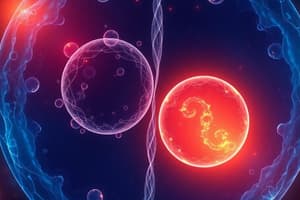Podcast
Questions and Answers
Which of these options describe mitosis? (Select all that apply)
Which of these options describe mitosis? (Select all that apply)
- Results in 4 unique haploid daughter cells
- Found in somatic and germ cells (correct)
- Involves pairing of homologous chromosomes
- Results in 2 identical daughter cells (correct)
Which is true about meiosis?
Which is true about meiosis?
- Involves both pairing of homologous chromosomes and results in unique daughter cells (correct)
- Found in somatic cells
- Results in 2 identical daughter cells
- Involves 2 rounds of cell division (correct)
Mitosis results in _____ identical daughter cells.
Mitosis results in _____ identical daughter cells.
2
Meiosis results in _____ unique haploid daughter cells.
Meiosis results in _____ unique haploid daughter cells.
In meiosis, homologous chromosomes pair up during metaphase.
In meiosis, homologous chromosomes pair up during metaphase.
What process is involved in mitosis?
What process is involved in mitosis?
What type of cell division does meiosis result in?
What type of cell division does meiosis result in?
What happens during anaphase II of meiosis?
What happens during anaphase II of meiosis?
Study Notes
Mitosis
- Occurs in somatic and germ cells
- Involves cytokinesis
- Has four phases: Prophase, Metaphase, Anaphase, and Telophase
- Maintains the same chromosome count in daughter cells
- Creates an exact copy of the original cell, a cloning process
- Homologous chromosomes do not pair up during mitosis
- Chromosomes line up single file during metaphase
- Results in two identical daughter cells
Meiosis
- Occurs only in germ cells
- Essential for sexual reproduction
- Involves two rounds of cell division
- Daughter cells have half the chromosome number of the original cell
- Has unique phases identified by roman numerals: Prophase I, Metaphase I, Anaphase I, Telophase I, Prophase II, Metaphase II, Anaphase II, Telophase II
- Produces unique cells, each containing pairs of homologous chromosomes
- Involves pairing of homologous chromosomes during metaphase I
- Ends with four unique haploid daughter cells
Stages of Meiosis II
- Anaphase II: Sister chromatids separate and are pulled apart
- Telophase II: Unduplicated chromosomes move to opposite cell poles
- Second cytoplasmic division: Each daughter cell becomes haploid
### Differences Between Mitosis and Meiosis
- Mitosis: one round of cell division, results in diploid daughter cells (same number of chromosomes as original cell)
- Meiosis: two rounds of cell division, results in haploid daughter cells (half the number of chromosomes as the original cell)
- Mitosis: produces identical daughter cells, essential for growth and repair
- Meiosis: produces unique daughter cells, essential for sexual reproduction
Studying That Suits You
Use AI to generate personalized quizzes and flashcards to suit your learning preferences.
Related Documents
Description
Test your knowledge on the processes of mitosis and meiosis, including their phases and key differences. This quiz highlights the significance of these cell division processes in growth and reproduction. Perfect for biology students seeking to solidify their understanding of cell biology.





